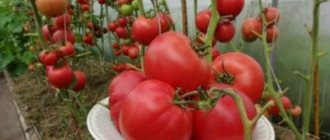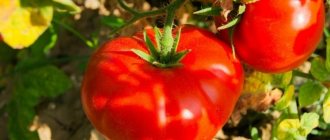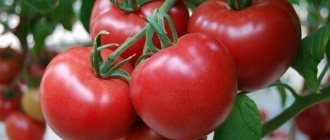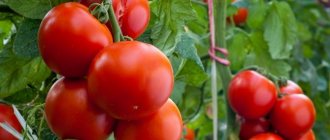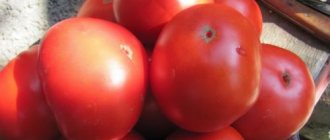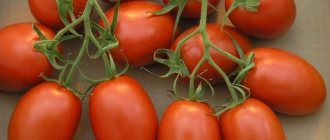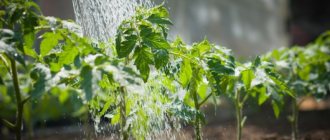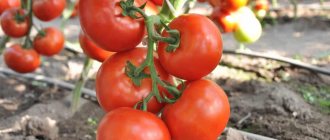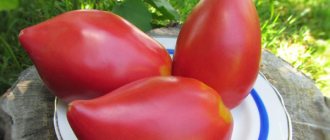For Russian expanses, tomatoes are a relatively young vegetable crop. Tomatoes, once brought to Europe from America, gained popularity for a long time, because initially they were considered poisonous. But now it’s difficult to imagine national cuisine without delicious, nutritious fruits (at the same time, winter is not a hindrance for a gourmet).
Among the many varieties, one variety of tomatoes has recently become the most sought after for its qualities. People call them Cream - the shape of the fruits actually resembles this fruit.
The popularity of tomatoes has prompted breeders to create many varieties of plum tomatoes. They are united by the characteristics of the species, but each variety has its own characteristics.
Characteristics and description of the variety, yield indicators
Cream has a wide variety of varieties: early ripening, late ripening, low-growing and tall, even indeterminate vines. Most subspecies are intended for open beds, but some of them develop better in greenhouses. This variety is known throughout the world due to its unusual oblong shape, reminiscent of a plum.
Cream tomatoes are a high-yielding variety of tomatoes that come in a variety of flesh colors. Depending on the variety, the fruits come in bright red, orange, violet-blue and other colors. Housewives prefer pink cream; they say these tomatoes are the most delicious and tender.
The weight of the fruit varies between 50-120 g. From 7 to 10 kg of fruit are collected from one square meter of tomato plantings. The vegetable has a strong skin and dense pulp that does not crack during storage and transportation. The fruit contains a small number of grains.
There are more than a dozen varieties of Cream. Tomatoes ripen in the same time as regular tomatoes:
- early - up to 90 days;
- medium - up to 120 days;
- late ripening - over 120 days.
The fruits also contain a small amount of liquid, which is why they are not used for making juices. Tomatoes are low-calorie; 100 g contains 22 kcal. The branching of the bushes is average. The leaves are dark green in color, the inflorescences are light yellow. The height of an average bush is 40-70 cm, but some subspecies reach 1.5-2.5 m.
On a note. Small Slivka tomatoes can be successfully grown even on a veranda, windowsill or balcony.
Moscow region beds
Siberian tomatoes
In each region of Russia, summer residents have their own favorite varieties of tomatoes. If you consider the characteristics and description of the tomato variety Slivovka and others in the table below, you can understand why they are so attractive to gardeners in the Moscow region.
Tomatoes popular in the Moscow region
| Variety | Peculiarities |
| Slivovka | · An extra-early variety that produces a nice cream with a “spout.” The red fruits are smooth, slightly flattened at the stalk. They have low-juicy, fleshy pulp and a sour taste; |
| · Gardeners are attracted by its unpretentiousness, good immunity, the formation of ovaries, regardless of weather conditions, and the friendly yield of the harvest; | |
| · The fruits are marketable and transportable. If you pick them up from the bush when they are brown, they will rest quietly in the cellar until the beginning of winter. Good at preserving | |
| Cream Honey Tomato | · The hybrid variety is represented by determinate standard bushes. Despite their early maturity, they are grown not only in open ground, but also in greenhouses; |
| · The smooth red fruit with fleshy pulp has high tasting qualities and a pleasant aroma. A special feature of the Honey Cream tomato is the small number of chambers with seeds; | |
| · With tomatoes weighing up to 70 g, you can get about 4.5 kg from one square meter; | |
| · The variety is characterized by the following qualities: cream marketability, disease resistance, stable yield | |
| Moscow | · This is not just a variety - under this name there are several varieties of the crop, differing in color shades. The most popular among farmers are chocolate and yellow; |
| · Slivka Moskovskaya tomatoes have a sweetish taste with a slight piquant note, which allows the variety to be used more often than others for making ketchups and sauces; | |
| · The fruits are elastic, with low moisture content and a high percentage of glucose. At the time of ripening, tomatoes reach a weight of 130 g, which ensures good yield; | |
| · The variety is unpretentious to growing conditions, but has weak immunity to fungal diseases | |
| lady finger | · Determinate bush, up to 1 m high, bears fruit 3.5 months after planting. Graceful tomatoes are shaped like their name. Elongated tomatoes grow up to 8 cm in length and gain an average mature weight of 140 g; |
| · From one square meter, using conventional agricultural technology, a summer resident collects up to 6 kg of elastic fruits with a glossy skin. They are suitable for long-term transportation, retain marketability for a long time and have good taste. |
Having studied all the characteristics of tomatoes, gardeners select those that they like most. When choosing varieties for open ground, the emphasis is on regionality, because for areas with a short growing season you should not choose late-ripening Cream.
Advantages and disadvantages of Cream
Advantages of Cream and its varieties:
- the variety gives a bountiful harvest;
- all Creams are beautiful to look at;
- tomatoes are stored for a long time and practically do not spoil;
- tomatoes have a sweet, delicate taste;
- tomatoes are easy to grow;
- fruits are convenient to transport;
- universal in use;
- The variety is resistant to pests and diseases.
There were practically no flaws in the variety, except for the need for regular fertilizing and watering.
The most popular varieties
Let's look at the most popular varieties of Cream.
Moscow Cream . The variety is early ripening, the harvest is harvested 100-110 days after planting the seeds. The culture is intended for cultivation both in greenhouse conditions and in open ground. It is famous for its high yield and strong immunity.
Royal Cream is an early ripening variety. It is usually grown in open ground under a film. The bush grows to 60-75 cm, but at the same time gives a bountiful harvest. Royal tomatoes have an elongated cylindrical shape and have a pleasant smell.
Yellow Cream . Tomatoes are valued for their ease of care and excellent taste. The bush grows up to 1.5 m and needs staking. In open ground gardens, they are grown only in warm areas with early spring and hot summers. This type of cultivation requires additional watering. This variety is early ripening, the fruits are harvested 90 days after planting.
Argentine Cream Red. The variety is productive, mid-season. The height of the bush reaches 2 m. Beautiful fruits have an excellent taste. The weight of the fruit is small - only up to 80 g. Tomatoes are ideal for canning. In addition, the crop has a stable immunity to diseases and does not suffer from pests.
Brazilian Cream . The crop with such an exotic name grows up to 1.5 m. Small, bright red fruits weigh up to 60-70 g and are pear-shaped. Tomatoes taste sweet. The variety is grown only in a greenhouse, but the scope of application is not limited.
Honey Cream . This variety has strong immunity and good disease resistance. Tomatoes are easy to care for and are great for growing by novice gardeners. The fruits are bright red in color and have a wonderful sweet taste. The weight of the fruit rarely exceeds 50-70 g.
The Black Plum tomato is a mid-season variety that is intended for growing in open ground. The bushes reach 2.5 m. The crop bears fruit in 110-120 days. The color of tomatoes is not always black, but rather varies from dark red to purple-blue.
Cio-chio-san . A tall, branched subspecies that looks like a tomato tree. It is grown both in open ground and in greenhouse conditions. A distinctive feature of the variety is large clusters with an abundance of pink fruits.
Sunny bunny F1 . The hybrid is early ripening and tall. Recommended for growing in greenhouse conditions. The bush has small clusters with bright yellow fruits of a delicate sweet taste, and has strong immunity to diseases and pests.
Cream giant . The bush grows tall and produces a large, abundant harvest of tomatoes. The fruits ripen 115 days after sowing the seeds, the average weight of one vegetable is 100-120 g. The fleshy tomato has a sour taste, is stored for a long time and tolerates transportation well.
Watercolor . The Siberian variety is an early ripening variety (the harvest is harvested within three months after sowing the seed). Watercolors do not need gartering or pinching. Red tomatoes have an oval shape and an average weight of up to 120 g. The high-yielding variety is resistant to septoria and rot.
For your information. In medicine, tomatoes are often used as a medicine for burns and wounds, since their pulp contains phytoncides that prevent the development of infections.
Subtleties of successful cultivation and care
To obtain strong seedling material, it is important to follow the rules of care. Failure to comply with certain requirements can lead not only to illness, but even to the death of the future harvest.
Attention! Adjustment of growing conditions directly depends on the region in which the plants are planned to be planted.
Growing and planting seedlings
Tomato cream is usually grown in seedlings. The most successful month for planting seedlings is March. It is best to use a special nutrient soil that initially contains the necessary microelements.
Seedling
To obtain strong seedlings, the following basic rules must be observed:
- The room temperature must be at least +25 degrees.
- Daylight hours are 12-14 hours. If necessary, additional lighting can be installed.
- Moderate watering.
- Timely feeding.
Attention! Before planting, you need to cull the bad seeds.
The prepared seed material is dipped into warm salty water. Only those seeds that remain at the bottom should be used for growing. The next stage is disinfection. The best way is to soak in a weak solution of manganese for 30 minutes.
How to grow Slivka
Seeds are sown in late winter-early spring (February-March). The timing is set depending on the variety itself and the time of growing seedlings (from 45 to 75 days).
What should the soil be like?
The soil for growing tomatoes should be slightly acidic or neutral. If the acidity of the soil is increased, dolomite flour (crushed lime, wood ash) is introduced into it.
The site is not suitable for tomatoes if pepper, eggplant, and physalis grew on it last year. Otherwise, the rules of crop rotation will be violated.
To get a bountiful harvest, the soil is fertilized with organic matter. To do this, in the fall you should scatter rotted mullein or compost (a bucket per square meter). Phosphorus-potassium supplements (20 g per square meter) are also important.
At the beginning of spring, it is recommended to enrich the soil with nitrogen fertilizers, which have a beneficial effect on the growth of young shoots.
Sowing rules
Before sowing, the seeds must be warmed up by placing them in a warm place (two days at +30 °C, then three days at +50 °C) and soaked for 30 minutes in a slightly pink solution of potassium permanganate. The soil for tomatoes is disinfected by spraying with the preparation “EM-Baikal”.
Pots or wooden boxes with a height of at least 10 cm are suitable as containers. Peat tablets are also used. The depth of planting seeds in moist soil is 1 cm. After planting the material, cover the container with film.
Suitable conditions for seedlings:
- for seed germination, set the temperature to approximately +25 °C;
- after a week, remove the film and place the seedlings in a well-lit place;
- we lower the temperature: at night to +8...+10 °C, during the day +10...+15 °C;
- after 7 days we increase the temperature: at night to +14...+16 °C, during the day + 20...+25 °C.
The room with seedlings must be ventilated, but at the same time avoid drafts and a critical drop in temperature.
Transplanting tomatoes into open ground
Seedlings are planted during the period when positive night temperatures are established (late May-early June). For one sq. m have 3-5 plants. By that time the bush will get stronger and will have 7-8 leaves.
The culture is transplanted into moistened holes at right angles to the ground. The soil is compacted over the roots. A fourth or even a third of the stem is placed in the soil. If the region is windy and characterized by heavy precipitation, it is advisable to install a small peg for each plant, which will serve as a support for it.
Caring for Slivka after transplantation
The rules for caring for Slivka are practically no different from the agricultural technology of tomatoes in general.
For normal growing of tomatoes, the garden bed needs to be weeded regularly. Removing weeds is done to prevent planting from becoming too dense, which provokes fungal diseases and attracts pests. In addition, weeds are dangerous because they absorb all the moisture and beneficial minerals found in the soil, thereby robbing the tomatoes and preventing them from growing and developing normally.
Loosening is carried out for better development of the root system, which saturates the soil with oxygen and prevents stagnation of moisture.
As a rule, both procedures (weeding and loosening) are combined. Hill up bushes to increase their stability. This is especially important for tall subspecies and windy environments.
The bed is watered 2-3 times a week (6-7 liters of non-cold water per sq. m). In stagnant hot weather, the amount of liquid is increased to 10 liters per square meter. m. Soil moistening is carried out either in the morning or in the evening. The main thing is not in open sunlight.
It is better to use a drip irrigation system for the crop. Sprinkling causes the inflorescences to fall off. Conventional irrigation with a hose is carried out at the root with low pressure.
On a note. The simplest drip irrigation system is made from ordinary plastic bottles. We cut off the bottom, make several holes in the cap, dig the bottle neck down near each bush and fill it with water. The advantage of the system is that you can replenish moisture reserves at any time of the day and in any weather.
During the entire growing season, the crop is fed at least twice. The first fertilizer is carried out 3 weeks after planting the seedlings in open ground, the second - after another 3 weeks, during the onset of intensive fruit formation.
To prepare the nutritional mixture, a combination of the following components is used:
- potassium (15 g);
- nitrogen fertilizers (25 g);
- phosphorus substances (40 g);
- water (10 l).
Mineral fertilizers are applied dry in the inter-row spaces.
As the bush forms, the stepsons are removed once a week. In the second half of August, the tops are pinched so that the fruits themselves develop better. The lower leaves take away the plant's strength and must also be plucked off.
Some vegetable growers make mistakes when growing tomatoes. Here are the most common:
- plant tomatoes in the same place every year;
- seedlings are planted tightly - if the seedlings are planted close to each other, they cannot develop normally;
- violate the watering regime (both drought and abundance of moisture are dangerous for tomatoes);
- they introduce too much fertilizer, overfeeding the plants, which leads to the expenditure of resources on the growth of tops rather than on fruit set.
For your information. It is better to plant tomatoes at different ripening periods. This way you will get a continuous harvest of tomatoes from June to October.
Agricultural technology of tomatoes Cream
This variety is grown according to the same principle as any other tomato variety - in seedlings.
Tomatoes Minusinsk
Productivity primarily depends on the quality of the seeds used:
- They should not be hollow, which is easy to check by immersing them in a saline solution. Full-bodied seeds will sink to the bottom, and those that float should be discarded;
- Deformed seeds are also not used - they will produce low-quality seedlings;
- To prevent diseases, seeds are disinfected by immersing them in a solution of hydrogen peroxide or potassium permanganate for 10 minutes.
Note! To speed up germination, after planting the seeds, it is recommended to cover the soil in the seedling box with a damp cloth.
The soil should also be disinfected and then fertilized. To avoid excess moisture, containers for seedlings are chosen with drainage holes. 2 months after sowing, the seedlings can be sent to the beds using the standard step-by-step planting algorithm.
Planting tomatoes
When caring for cream, special attention is paid to fertilizing. Experienced summer residents offer several options for nutrient mixtures to which this variety of tomatoes is responsive.
Fertilizers for tomatoes Cream
| Application period | Composition (per 10 liters of water) |
| The beginning of June | · Mullein – 5 l, boric acid – 3 g, nitrophoska – 1 tbsp, microfertilizers – 2 tablets; |
| · 0.8 kg of fertilizer is applied to each bush | |
| First week of July | Mullein and microfertilizers are mixed with potassium sulfate (1 tbsp.) |
| Weekly | Weak solution of manganese (5 g crystals) |
| After harvest | 2 kg of organic matter per 1 sq.m. plot (compost or manure) – without diluting with water |
Organic fertilizers are applied to the soil in the fall when digging the area prepared for planting tomatoes next year.
Watering
Cream varieties do not like dry weather, so they need to be watered regularly. But excess moisture is not allowed - this is harmful to the root system. Therefore, during the rainy season and in cool weather, watering is not carried out.
Drip irrigation of tomatoes
The water should be warm enough so that the plants do not get sick. Only the soil around the trunk is watered. To prevent moisture from getting on the foliage and fruits, it is advisable to equip the beds with drip irrigation.
Diseases
On a note! Not all varieties of Cream are disease resistant. To get rid of fungi and bacteria, it is recommended to treat the bushes with Fitosporin, Fundazol, Ridomil. When the first signs of the disease are detected, limp and affected leaves and stems must be removed immediately. To reduce the risk of damage, tomatoes should not be planted next to or after potatoes.
Prevention of diseases and pests
The variety has strong immunity. The crop is rarely susceptible to diseases of fusarium, wilt, late blight and rot. However, young plants are afraid of aphids and other insects. Pests are gotten rid of using the drugs “Actofit” or “Operkot”. To remove the Colorado potato beetle, use “Prestige” or “Regent”.
Attention! Many varieties of Cream are resistant to most diseases, but are prone to late blight and require treatment with drugs. Information about the crop's susceptibility to certain diseases must be indicated on the seed packaging. In this regard, hybrids are the most stable.
Prevention of TMV
Tobacco mosaic manifests itself in these tomatoes, as in any others, primarily in a change in leaf color to variegated. In this case, light spots appear on the fruits. Unfortunately, antiviral drugs have not yet been developed for this disease. Therefore, when growing tomatoes of the Slivki variety, it is important to pay maximum attention to the prevention of TMV. For planting, you should use only high-quality seeds purchased from reliable sellers. In autumn, all tops from the beds should be removed and burned. The same goes for fallen leaves in the garden.
Reviews of Slivka tomatoes
Cream has gained great popularity among gardeners. Most gardeners believe that these tomatoes are worthy of attention. However, there are those who do not like tomatoes. Let's look at some reviews about Slivka tomatoes.
Galina: “I love Slivka. We use these tomatoes in any form: we ferment them, can them, freeze them, and even dry them. I’m not even talking about eating it fresh—my grandchildren pick it straight from the garden. My entire family’s favorite varieties are Honey and Yellow Cream. They are the sweetest and brightest. I recommend these species for planting!”
Ivan: “I don’t like this variety. In my opinion, Slivka is a bit dry and requires a lot of attention. I prefer to grow and use classic varieties with large juicy fruits for canning and cooking.”
Tatyana: “I’ve been growing cream for a long time, about 10 years already. This variety was once recommended to me by a consultant at an agricultural store when I decided to diversify my beds with new types of tomatoes. Over the years, I have tried almost all subspecies, I especially liked Royal Cream for its abundant harvest, pleasant aroma and the opportunity to enjoy my favorite tomato at a time when others are just beginning to ripen. The cream is fleshy, strong, has a long shelf life and is easy to transport. I plant the seeds immediately in the ground, cover them with film and do not bother myself with unnecessary manipulations with the seedlings. I like growing Slivka because it is not fussy to care for and is not afraid of pests.”
Features of cultivation
Tomato seeds for growing seedlings are sown in March or early April. Planting depth is 1 cm. After two true leaves appear, picking begins. During the entire growing season, seedlings are fed three times with complex fertilizers. It is kept in a well-lit room with a temperature of 20–25 °C.
A week before planting in open ground, they begin hardening the Office Romance tomatoes. To do this, the plants are taken out into the open air every day, avoiding direct sunlight. The residence time is increased every day, starting from several hours. Tomatoes are planted in open ground as soon as the threat of overnight spring frosts has passed. By this time, the first flower cluster is usually formed on the seedlings. The Office Romance variety is planted according to a 30×50 cm pattern.
Caring for plantings involves regular systematic watering and loosening the soil. They control weeds and fertilize tomatoes. Despite the fact that tomatoes of this variety are resistant to diseases, measures to prevent fungal diseases will be useful. For this purpose, the beds are treated with Bordeaux mixture. During the entire season, no more than three fertilizings with complex fertilizers are carried out.
Office romance is used both for cultivation on private plots and on an industrial scale. The harvested crop is used for preservation, preparation of tomato paste, juices, fresh consumption, and sale. In unfavorable weather conditions, it is still possible to harvest a decent harvest of tasty fruits.

